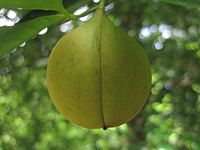Myristic acid
Appearance

| |
| Names | |
|---|---|
| Preferred IUPAC name
Tetradecanoic acid | |
| Other names
C14:0 (
Lipid numbers ) | |
| Identifiers | |
3D model (
JSmol ) |
|
| ChEBI | |
| ChEMBL | |
| ChemSpider | |
ECHA InfoCard
|
100.008.069 |
| EC Number |
|
IUPHAR/BPS |
|
PubChem CID
|
|
RTECS number
|
|
| UNII | |
CompTox Dashboard (EPA)
|
|
| |
| |
| Properties | |
| C14H28O2 | |
| Molar mass | 228.376 g·mol−1 |
| Appearance | colorless or white solid |
| Density | 1.03 g/cm3 (−3 °C)[2] 0.99 g/cm3 (24 °C)[3] 0.8622 g/cm3 (54 °C)[4] |
| Melting point | 54.4 °C (129.9 °F; 327.5 K)[9] |
| Boiling point | 326.2 °C (619.2 °F; 599.3 K) at 760 mmHg 250 °C (482 °F; 523 K) at 100 mmHg[4] 218.3 °C (424.9 °F; 491.4 K) at 32 mmHg[3] |
| 13 mg/L (0 °C) 20 mg/L (20 °C) 24 mg/L (30 °C) 33 mg/L (60 °C)[5] | |
| Solubility | Soluble in alcohol, acetates, C6H6, haloalkanes, phenyls, nitros[5] |
| Solubility in acetone | 2.75 g/100 g (0 °C) 15.9 g/100 g (20 °C) 42.5 g/100 g (30 °C) 149 g/100 g (40 °C)[5] |
| Solubility in benzene | 6.95 g/100 g (10 °C) 29.2 g/100 g (20 °C) 87.4 g/100 g (30 °C) 1.29 kg/100 g (50 °C)[5] |
| Solubility in methanol | 2.8 g/100 g (0 °C) 17.3 g/100 g (20 °C) 75 g/100 g (30 °C) 2.67 kg/100 g (50 °C)[5] |
| Solubility in ethyl acetate | 3.4 g/100 g (0 °C) 15.3 g/100 g (20 °C) 44.7 g/100 g (30 °C) 1.35 kg/100 g (40 °C)[5] |
| Solubility in toluene | 0.6 g/100 g (−10 °C) 3.2 g/100 g (0 °C) 30.4 g/100 g (20 °C) 1.35 kg/100 g (50 °C)[5] |
| log P | 6.1[4] |
| Vapor pressure | 0.01 kPa (118 °C) 0.27 kPa (160 °C)[6] 1 kPa (186 °C)[4] |
| -176·10−6 cm3/mol | |
Thermal conductivity
|
0.159 W/m·K (70 °C) 0.151 W/m·K (100 °C) 0.138 W/m·K (160 °C)[7] |
Refractive index (nD)
|
1.4723 (70 °C)[4] |
| Viscosity | 7.2161 cP (60 °C) 3.2173 cP (100 °C) 0.8525 cP (200 °C) 0.3164 cP (300 °C)[8] |
| Structure | |
| Monoclinic (−3 °C)[2] | |
| P21/c[2] | |
a = 31.559 Å, b = 4.9652 Å, c = 9.426 Å[2] α = 90°, β = 94.432°, γ = 90°
| |
| Thermochemistry | |
Heat capacity (C)
|
432.01 J/mol·K[4][6] |
Std enthalpy of (ΔfH⦵298)formation |
−833.5 kJ/mol[4][6] |
Std enthalpy of (ΔcH⦵298)combustion |
8675.9 kJ/mol[6] |
| Hazards | |
| GHS labelling: | |
 [10] [10]
| |
| Warning | |
| H315[10] | |
| NFPA 704 (fire diamond) | |
| Flash point | > 110 °C (230 °F; 383 K)[11] |
| Lethal dose or concentration (LD, LC): | |
LD50 (median dose)
|
>10 g/kg (rats, oral)[11] |
| Related compounds | |
Related esters of myristic acid
|
Myristylbenzylmorphine
Dimyristoylphosphatidylethanolamine |
Related compounds
|
Pentadecanoic acid
|
Except where otherwise noted, data are given for materials in their standard state (at 25 °C [77 °F], 100 kPa).
| |
Myristic acid (
binomial name for nutmeg (Myristica fragrans), from which it was first isolated in 1841 by Lyon Playfair.[12]
Occurrence

Nutmeg butter has 75% trimyristin, the triglyceride of myristic acid and a source from which it can be synthesised.[13] Besides nutmeg, myristic acid is found in palm kernel oil, coconut oil, butterfat, 8–14% of bovine milk, and 8.6% of breast milk as well as being a minor component of many other animal fats.[9] It is found in spermaceti, the crystallized fraction of oil from the sperm whale. It is also found in the rhizomes of the Iris, including Orris root.[14][15]
Chemical behaviour
Myristic acid acts as a
biomembranes.[16]
Reduction of myristic acid yields myristyl aldehyde and myristyl alcohol
.
Health effects
Myristic acid consumption raises low-density lipoprotein (LDL) cholesterol.[17][18]
See also
References
- ^ Merck Index, 11th Edition, 6246
- ^ a b c d Bond, Andrew D. (2003). "On the crystal structures and melting point alternation of the n-alkyl carboxylic acids" (PDF). RSC.org. Royal Society of Chemistry. Retrieved 17 June 2014.
- ^ a b Chuah, T.G.; Rozanna, D.; Salmiah, A.; Thomas, Choong S.Y.; Sa’ari, M. (2006). "Fatty Acids used as Phase Change Materials (PCMs) for Thermal Energy Storage in Building Material Applications" (PDF). University Putra Malaysia. Retrieved 17 June 2014.
- ^ ISBN 978-1-4200-9084-0.
- ^ a b c d e f g Seidell, Atherton; Linke, William F. (1940). Solubilities of Inorganic and Organic Compounds (3rd ed.). New York: D. Van Nostrand Company. pp. 762–763.
- ^ a b c d Tetradecanoic acid in Linstrom, Peter J.; Mallard, William G. (eds.); NIST Chemistry WebBook, NIST Standard Reference Database Number 69, National Institute of Standards and Technology, Gaithersburg (MD)
- ISBN 978-0-8493-9345-7.
- ISBN 978-0-8155-2039-9.
- ^ S2CID 84492006.
- ^ a b Sigma-Aldrich Co., Myristic acid.
- ^ a b c "Myristic Acid". ChemicalLand21.com. AroKor Holdings Inc. Retrieved 17 June 2014.
- ISSN 1941-5966.
- .
- ^ Council of Europe, August 2007 Natural Sources of Flavourings, Volume 2, p. 103, at Google Books
- ^ John Charles Sawer Odorographia a natural history of raw materials and drugs used in the perfume industry intended to serve growers, manufacturers and consumers, p. 108, at Google Books
- ISBN 978-0716743392.)
{{cite book}}: CS1 maint: multiple names: authors list (link - ^ Mensink, Ronald P. (2016). "Effects of saturated fatty acids on serum lipids and lipoproteins: a systematic review and regression analysis" (PDF). World Health Organization.
- PMID 30006369.
Wikimedia Commons has media related to Myristic acid.

